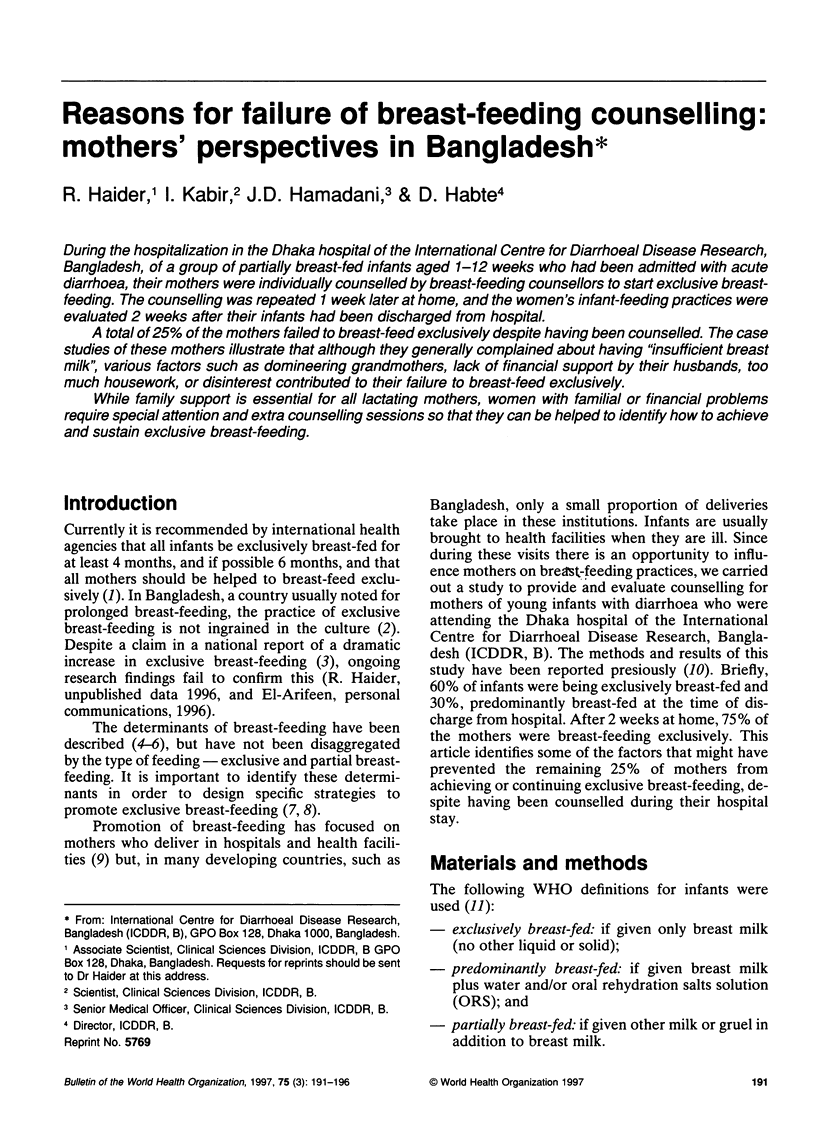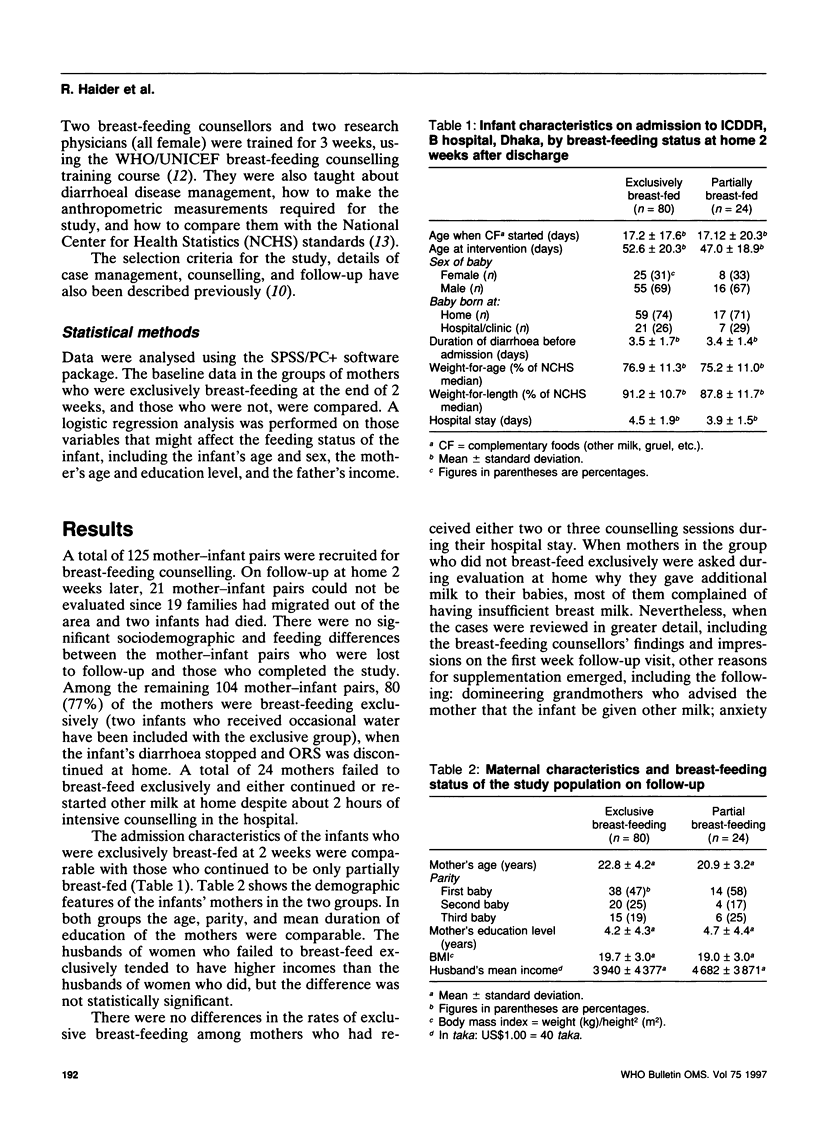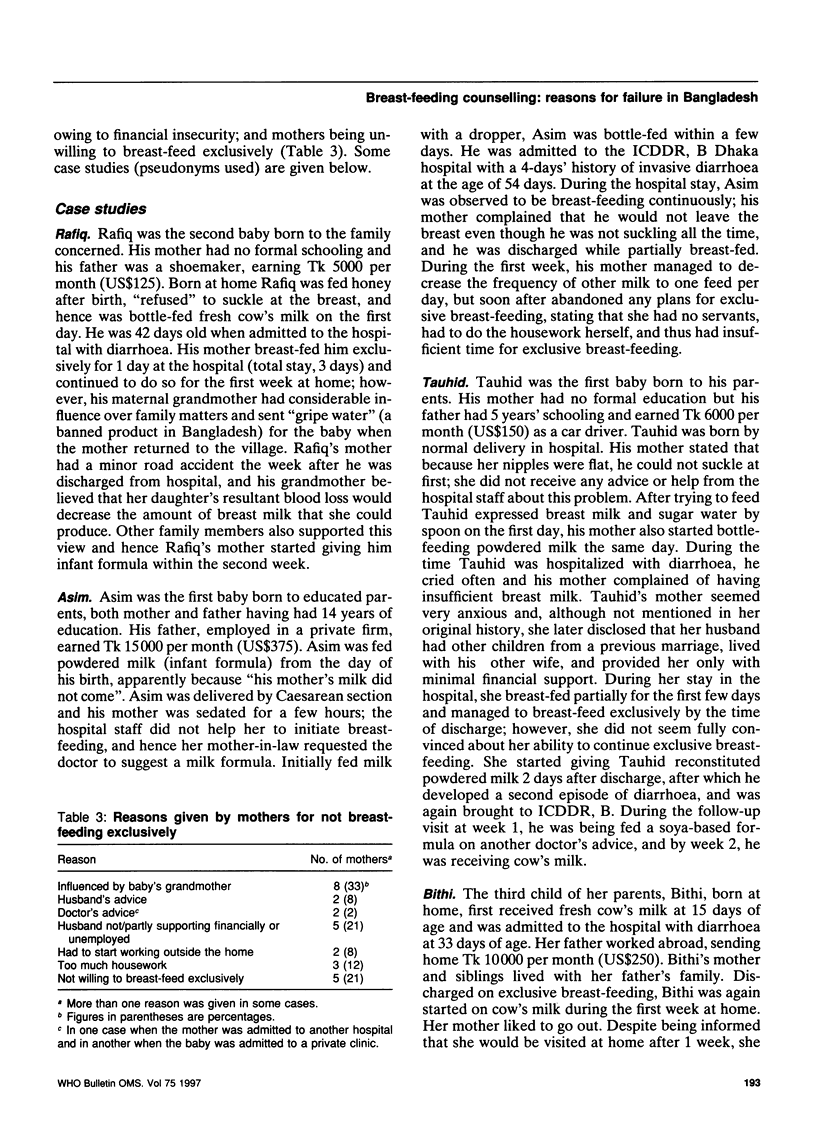Abstract
During the hospitalization in the Dhaka hospital of the international Centre for Diarrhoeal Disease Research, Bangladesh, of a group of partially breast-fed infants aged 1-12 weeks who had been admitted with acute diarrhoea, their mothers were individually counselled by breast-feeding counsellors to start exclusive breast-feeding. The counselling was repeated 1 week later at home, and the women's infant-feeding practices were evaluated 2 weeks after their infants had been discharged from hospital. A total of 25% of the mothers failed to breast-feed exclusively despite having been counselled. The case studies of these mothers illustrate that although they generally complained about having "insufficient breast milk" various factors such as domineering grandmothers, lack of financial support by their husbands, too much housework, or disinterest contributed to their failure to breast-feed exclusively. While family support is essential for all lactating mothers, women with familial or financial problems require special attention and extra counselling sessions so that they can be helped to identify how to achieve and sustain exclusive breast-feeding.
Full text
PDF





Selected References
These references are in PubMed. This may not be the complete list of references from this article.
- Adair L. S., Popkin B. M., Guilkey D. K. The duration of breast-feeding: how is it affected by biological, sociodemographic, health sector, and food industry factors? Demography. 1993 Feb;30(1):63–80. [PubMed] [Google Scholar]
- Bacon C. J., Wylie J. M. Mothers' attitudes in infant feeding at Newcastle General Hospital in summer 1975. Br Med J. 1976 Feb 7;1(6005):308–309. doi: 10.1136/bmj.1.6005.308. [DOI] [PMC free article] [PubMed] [Google Scholar]
- Bevan M. L., Mosley D., Solimano G. R. Factors influencing breast feeding in an urban WIC program. J Am Diet Assoc. 1984 May;84(5):563–567. [PubMed] [Google Scholar]
- Black R. F., Blair J. P., Jones V. N., DuRant R. H. Infant feeding decisions among pregnant women from a WIC population in Georgia. J Am Diet Assoc. 1990 Feb;90(2):255–259. [PubMed] [Google Scholar]
- Bryant C. A. The impact of kin, friend and neighbor networks on infant feeding practices. Cuban, Puerto Rican and Anglo families in Florida. Soc Sci Med. 1982;16(20):1757–1765. doi: 10.1016/0277-9536(82)90269-6. [DOI] [PubMed] [Google Scholar]
- Cohen R. J., Haddix K., Hurtado E., Dewey K. G. Maternal activity budgets: feasibility of exclusive breastfeeding for six months among urban women in Honduras. Soc Sci Med. 1995 Aug;41(4):527–536. doi: 10.1016/0277-9536(94)00354-v. [DOI] [PubMed] [Google Scholar]
- Forman M. R. Review of research on the factors associated with choice and duration of infant feeding in less-developed countries. Pediatrics. 1984 Oct;74(4 Pt 2):667–694. [PubMed] [Google Scholar]
- Freed G. L., Jones T. M., Schanler R. J. Prenatal determination of demographic and attitudinal factors regarding feeding practice in an indigent population. Am J Perinatol. 1992 Sep-Nov;9(5-6):420–424. doi: 10.1055/s-2007-999279. [DOI] [PubMed] [Google Scholar]
- Goodine L. A., Fried P. A. Infant feeding practices: pre- and postnatal factors affecting choice of method and the duration of breastfeeding. Can J Public Health. 1984 Nov-Dec;75(6):439–444. [PubMed] [Google Scholar]
- Haider R., Islam A., Hamadani J., Amin N. J., Kabir I., Malek M. A., Mahalanabis D., Habte D. Breast-feeding counselling in a diarrhoeal disease hospital. Bull World Health Organ. 1996;74(2):173–179. [PMC free article] [PubMed] [Google Scholar]
- James D. C., Jackson R. T., Probart C. K. Factors associated with breast-feeding prevalence and duration among international students. J Am Diet Assoc. 1994 Feb;94(2):194–196. doi: 10.1016/0002-8223(94)90248-8. [DOI] [PubMed] [Google Scholar]
- Jones D. A. Attitudes of breast-feeding mothers: a survey of 649 mothers. Soc Sci Med. 1986;23(11):1151–1156. doi: 10.1016/0277-9536(86)90333-3. [DOI] [PubMed] [Google Scholar]
- Jones R. A., Belsey E. M. Breast feeding in an inner London borough--a study of cultural factors. Soc Sci Med. 1977 Feb;11(3):175–179. doi: 10.1016/0037-7856(77)90090-7. [DOI] [PubMed] [Google Scholar]
- Matich J. R., Sims L. S. A comparison of social support variables between women who intend to breast or bottle feed. Soc Sci Med. 1992 Apr;34(8):919–927. doi: 10.1016/0277-9536(92)90260-w. [DOI] [PubMed] [Google Scholar]
- Novotny R., Kieffer E. C., Mor J., Thiele M., Nikaido M. Health of infant is the main reason for breast-feeding in a WIC population in Hawaii. J Am Diet Assoc. 1994 Mar;94(3):293–297. doi: 10.1016/0002-8223(94)90371-9. [DOI] [PubMed] [Google Scholar]
- Pérez-Escamilla R. Breast-feeding patterns in nine Latin American and Caribbean countries. Bull Pan Am Health Organ. 1993;27(1):32–42. [PubMed] [Google Scholar]
- Pérez-Escamilla R., Lutter C., Segall A. M., Rivera A., Treviño-Siller S., Sanghvi T. Exclusive breast-feeding duration is associated with attitudinal, socioeconomic and biocultural determinants in three Latin American countries. J Nutr. 1995 Dec;125(12):2972–2984. doi: 10.1093/jn/125.12.2972. [DOI] [PubMed] [Google Scholar]
- Ryan A. S., Rush D., Krieger F. W., Lewandowski G. E. Recent declines in breast-feeding in the United States, 1984 through 1989. Pediatrics. 1991 Oct;88(4):719–727. [PubMed] [Google Scholar]
- Sciacca J. P., Phipps B. L., Dube D. A., Ratliff M. I. Influences on breast-feeding by lower-income women: an incentive-based, partner-supported educational program. J Am Diet Assoc. 1995 Mar;95(3):323–328. doi: 10.1016/S0002-8223(95)00083-6. [DOI] [PubMed] [Google Scholar]
- Winikoff B., Laukaran V. H. Breast feeding and bottle feeding controversies in the developing world: evidence from a study in four countries. Soc Sci Med. 1989;29(7):859–868. doi: 10.1016/0277-9536(89)90085-3. [DOI] [PubMed] [Google Scholar]


